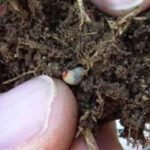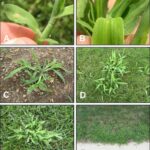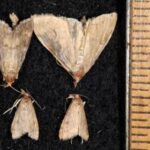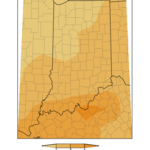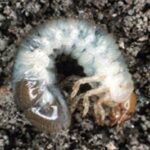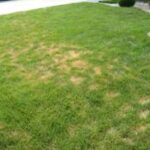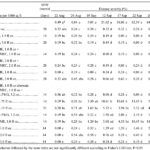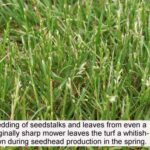Turf Tips Archives
Summer Stress
With a warm and wet summer, we are experiencing decline in some of our turf around the state due to temperatures, disease, insects, and weeds. In response, we are publishing a four part series on this topic to help turfgrass managers respond. Look forward to the following topics over the next two weeks. Part I: […]
Crabgrass
Crabgrass is running rampant this year as the hot summer and more than adequate rainfall has helped to push this beast of a weed along. Crabgrass is a warm-season annual grass meaning that it thrives under hot and moist conditions. The high rainfall during germination (late April and early May) coupled with the wet and […]
Grass Moths Everywhere
If you have walked out on your lawn recently you may have noticed hundreds of small, buff colored, moths flittering here or there as you approach. These may be alarming for both farmers as well as turfgrass managers because they; look like a common corn pest (European Corn Borer) act like a common turfgrass pest […]
Summer Stress
With a warm and wet summer, we are experiencing decline in some of our turf around the state due to temperatures, disease, insects, and weeds. In response, we are publishing a four part series on this topic to help turfgrass managers respond. Look forward to the following topics over the next two weeks. Part I: […]
Summer Stress
Summer Stress With a warm and wet summer, we are experiencing decline in some of our turf around the state due to temperatures, disease, insects, and weeds. In response, we are publishing a four part series on this topic to help turfgrass managers respond. Look forward to the following topics over the next two weeks. […]
August Is Grub Target Month
This is the time of year to target for grub control. Whether your grub control products were applied a month ago, last week or are to be applied next week, the time when they actually do their work is early August. This is because grub eggs usually hatch by the end of July in the […]
Summer Stress
Part I: Too hot: Why some turfgrass species look poor in summer. There are multiple causes for turf decline in the summer. Cool-season turf areas can decline in the summer because of high temperatures, drought, pest damage (insects, diseases, weeds, others), and due to mismanagement. The general symptoms for many of these causes are usually […]
Gray Leaf Spot 2010
Gray leaf spot has been identified on perennial ryegrass fairways in northern Kentucky. It is likely that outbreaks will occur in southern Indiana with the next rainstorm (or it may already be established). If the turf that you manage has a history of the disease, this would be a good time to consider apply a […]
Contact Information for Dr. Aaron Patton
Dr. Aaron Patton has joined the Turf Program as the Turf Extension Specialist. If you need to contact him, his contact infomation is Phone 765-494-9737 Fax 765-496-6335 email ajpatton@purdue.edu Department of Agronomy 915 W. State Street West Lafayette, IN 47907
Wet and Flooded Turf
Wet Lawns Although July has been relatively dry thus far, June brought a great deal of rain and left many lawn soils saturated and wet. Here are a few tips concerning caring for your lawn during wet periods. Flooded Turf Due to the incredible amount of rain Indiana has seen this summer, many homeowners are […]
Rain gardens and turf
There has recently been increased interest in the use of rain gardens to reduce water runoff in Indiana and nationally. A rain garden is a specially constructed area with a berm, planted with various plants, and designed to capture rain water from the roof of a house or building. Rain gardens fill with water after […]
Call Before Sending Samples to PPDL!
Our Plant and Pest Diagnostic Lab (PPDL) will be a little light on help over the next two weeks (June 19 – July 5). Remember that the lab processes samples from all plants and crops—and even though we try to give turf a high priority—there may be delays in how the samples are addressed. I […]
Slime mold
Slime mold can occur on all turf grasses. The disease does not infect the plant but instead grows on the outside of the leaves. Yellowish, purplish, or grayish fruiting bodies may be observed during wet periods. As the turf begins to dry, the structures become powdery. Since the disease is only cosmetic in nature, chemical […]
Goose Round-up – ‘Yee-Haw’
The Giant Canada goose (Anatidae: Branta canadensis maxima) recently has become one of the most serious pests of parks and golf courses in the Eastern half of the United States. These geese are probably the most adaptable of all waterfowl and, if left undisturbed, will readily establish nesting territories on ponds in residential subdivisions, condominium complexes, city […]
Turf Field Day on July 20
The Turf Field Day will be held on Tuesday, July 20 at the W.H. Daniel Turfgrass Research and Diagnostic Center in West Lafayette. The morning research tours include stops about Plant Growth Regulators, Broadleaf weed products, Controlling Moles and Voles, Dollar Spot Control and Exotic Invasive Insects in Ash and Elm Trees. Tradeshow and equipment demonstration featuring […]
Turf Disease Watch
The near term forecast indicates an early arrival of summer, when temperature and moisture conditions favor diseases that can cause serious damage to turf on golf courses, athletic fields and residential landscapes. Two of the more important diseases are discussed below. Brown Patch Brown patch is a foliar disease that does not damage crowns or […]
Dr. Aaron Patton Joining Purdue as Turf Extension Specialist
When I was 15 years old, I started working at the Indiana University golf course in Bloomington where I cleaned golf carts, helped out on the driving range, and occasionally worked in the pro shop. While there I had the opportunity to meet the golf course superintendent, Brent Emerick, and I began to be more […]
Sharpen Mower Blades
Due to the warm, wet weather we have been experiencing lately, homeowners are having to mow their lawns very frequently. Something to keep in mind throughout the summer is that the more often you mow your lawn, the more dull the mower blades become. Mower blades should be examined a few times throughout the growing […]
May Fertilization
Although it is generally preferable to fertilize home lawns in the fall, a late May fertilizer application can help the turf retain its color and vigor during the summer. If conservative nitrogen rates are used, fertilizer can be applied in late spring without dramatically increasing vertical growth. To aid the turf in keeping its color […]
Managing Seedheads
Kentucky bluegrass, tall fescue and perennial ryegrass all produce seedheads that look unsightly in lawns. These seedheads are easily visible in maintained turfgrass because they grow faster and more unevenly than normal grass blades. Also, since the seedhead stalks are so tough, they do not cut cleanly and leave a light green or white tip […]
